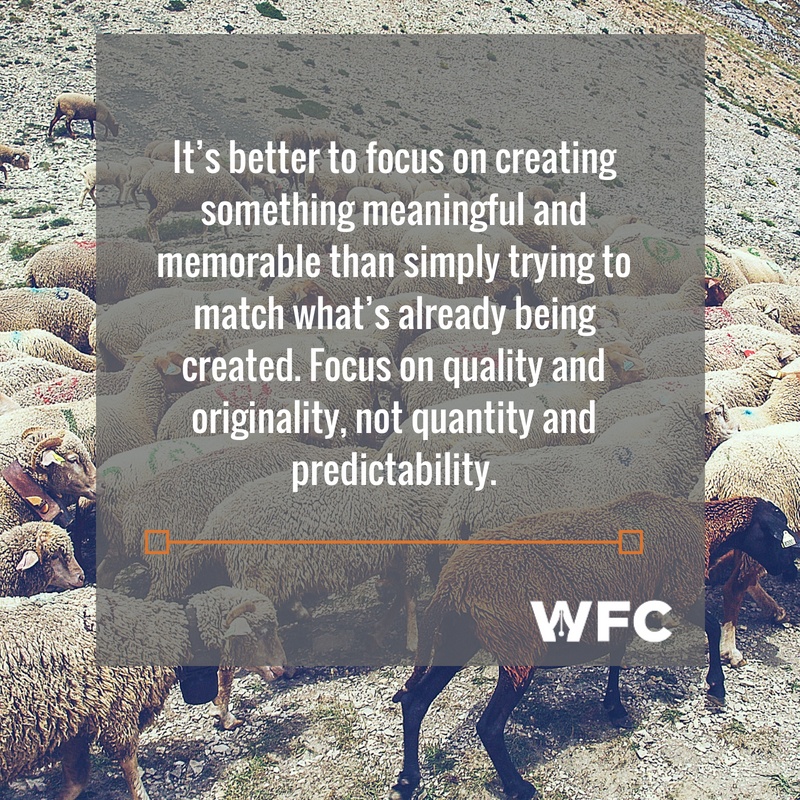Humor me for a moment by doing a quick exercise.
Open your Twitter feed and scroll through for a few minutes. What do you notice?
These days, you might not notice anything unique at all. Your mind naturally wanders down the screen as you endlessly scroll until you either, a) find an article that seems remotely relevant or interesting, or b) become impatient and move on to the next thing—which is likely just a few swipes away in some other social media platform or app.
The reason that you inevitably fall into this pattern is likely because there is very little content that stands out from the crowd. And this isn’t unique to Twitter. Use any other social media platform or scan your email inbox, and you’ll likely notice that, a) there is so much content out there, and b) everyone seems to be playing by the same set of rules and producing the same sort of things.
In short, there’s a herd mentality these days when it comes to creating and distributing content.
Don’t Get Trampled by the Herd
It’s easy to understand why this sort of herd mentality takes hold in the world of marketing—especially in a compliance-constrained industry like financial services, where most firms are afraid of breaking new ground. A few early adopters find success with a new type of marketing and establish rules, norms, and “best practices” for others to follow. The tactic then goes mainstream and, before long, seemingly everyone is trying to emulate that success. Eventually, some innovative soul tries something new, finds a different kind of success, and the cycle repeats itself.
We’re not immune to this at WFC. Although we try to be creative in how we produce our own thought leadership and content marketing—and we advise clients to do the same in the work that we do for them—there are many times when we feel just as compelled to adhere to the established best practices.
But it’s important for us and other financial marketers to remember that, sometimes, doing what everyone else is doing is counterproductive.

Just as it’s important for investment firms to find true differentiators when telling their firm’s story, it’s equally important for financial marketers to slow down and identify new, truly unique ways to build their brands and stand out from the crowd.
A Lesson from Amazon: Go Beyond the Herd to Find Your Own Way
Scott Wentworth, WFC’s head writer and founder, and I were reminded of the importance of avoiding the herd mentality when we both read Amazon’s annual shareholder letter earlier this year.
As shareholder letters go, this one stood out. The way that CEO and Founder Jeff Bezos wrote the letter—as well as the specific anecdotes that he included about the company’s practices—was a refreshing departure from what you’d expect to see in the buttoned-down world of investor communications.
Most investor letters begin with a drab overview of the company’s financial results for the year. Not Amazon. Its letter starts with brief remarks about the recognition that the company recently received; it then shifts into … a story about how one of Bezos’ friends tried to learn to do a perfect handstand.
Why is a company with a nearly $800 billion market capitalization talking about handstands?
The point of the story, according to Bezos, was to enter into a larger discussion about Amazon’s high standards and what it takes to achieve them. The handstand story illustrated that most people might think it shouldn’t take more than a few weeks to perfect a handstand. But Bezos’ friend, after hiring a handstand coach—that’s an actual profession, apparently—spent six months practicing daily to perfect it. She didn’t just want to be able to do a handstand; she wanted to do a flawless handstand, and she was willing to put in the time, commitment, and effort to do it.
In the letter, Bezos also talks about the company’s unique practice of banning PowerPoint presentations at its internal meetings. Instead, Amazon employees must write narratively structured six-page memos. Then, at the beginning of each meeting, everyone in attendance reads one of the memos in silence—a sort of “study hall,” Bezos writes.
He goes on to say that, in the years since establishing this memo-writing practice, Amazon’s employees have come to understand that the standards that go into creating a great memo follow the same path as Bezos’ friend in her effort to perfect the handstand.
Most Amazon employees who produce great memos, Bezos writes, understand that they can’t try and do a perfect handstand in two weeks; they know that a truly great memo may take weeks to get right before bringing it into a meeting—not simply a few hours, as people might initially expect.
“The key point here is that you can improve results through the simple act of teaching scope—that a great memo probably should take a week or more,” Bezos writes.
Define Your Own Best Practices
What’s the point in recalling these anecdotes from Amazon’s annual shareholder letter?
First, at WFC we believe that pouring a significant amount of energy into doing something unique and challenging and trying to execute it at an elite level—such as perfecting a handstand—is more valuable than doing something that many others are already doing.
In terms of content marketing, we believe that it’s better to focus on creating something meaningful and memorable than simply trying to match what’s already being created. In other words, focus on quality and originality, not quantity and predictability.
Just because one of your competitors is succeeding with one approach to content marketing or thought leadership doesn’t mean you should adopt that approach blindly. Remember: the point of content marketing in financial services is to look better than your competitors, not to look like your competitors.
Keep experimenting until you find an approach that aligns with your brand and resonates with your audience.
Most important, don’t be afraid to be different.
…
For more on how to write better investor letters or other financial communications, download our free e-book on the topic.
About the Author

Frank Kalman is the chief operations officer at Wentworth Financial Communications. Frank and the team of writers and editors at WFC help professionals across the financial services industry build their brands by creating investment-grade white papers, bylined articles, newsletters, blogs, social media posts, and other forms of content marketing.
